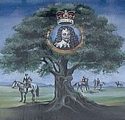
When Oliver Cromwell’s New Model Army won the Battle of Worcester in 1651, the British Monarchy seemed to be at an end. The main hope for survival lay with the son of the executed King Charles I, the young man who claimed the title King Charles II but who was now a fugitive. After the battle was lost and won, his only chance to keep hopes of a restoration alive was to escape the country. And so, the flight was on.
Charles was then on the run in Southern England for 43 days, making 9 different journeys, travelling for 17 days, covering an estimated 441 miles (nearly all on horseback), employing at least 38 key helpers, engaging with around 48 key locations, surviving 11 near encounters with troops, sleeping in 16 different places and hiding in 4 priest holes and 1 oak tree before escaping to France. Quite a tale. This artwork map shows the route he took.
The day after landing, Charles went to Rouen and then to Paris to stay with his mother, Queen Henrietta Maria. The next nine years were spent amongst such noble families of Paris and the Southern Netherlands, who were sympathetic to his plight. The death of Oliver Cromwell in 1658 however offered hope and the following two years in England were characterised by political confusion. Eventually George Monck, the Governor of Scotland, emerged as a dominant figure, leading the movement for the Restoration of the monarchy which took place in in 1660.
This site offers a telling of this story in a number of ways – by a narrative account, through a structured timeline, via a consideration of the characters involved, by examining the important locations of the journey and by listing his nine journeys. It also presents a collection of resources about Charles’s journey. It has been described in the Daily Telegraph as ‘entertaining, impressive and exhausive’.

The Monarch’s Way
This website has been inspired by the Monarch’s Way, a 625-mile walking route which approximately follows the path taken by Charles. I completed the walk with two friends in October 2023. The story of our journey is to be found here.
The Monarch’s Way walk does not attempt to follow the precise roads taken by Charles as he sought to escape from the Roundhead troops – most such roads have long since been surfaced over. What the Monarch’s Way does instead is to join together the various towns, villages, country houses and inns associated with the escape using walker-friendly rights-of-way and, in so doing, adding considerably to the mileage covered by Charles. The result is a unique lost-distance path – not merely because it is comfortably the longest way-marked inland walk in the UK, but also because it covers a wide variety of different landscapes. It passes through the Midlands, including the Black Country and the related World Heritage Site of Ironbridge Gorge, then extensively explores four National Landscapes – the Cotswolds, the Mendips, Dorset and Cranborne Chase – before a memorable journey through the South Downs National Park and finally arriving at the Sussex coast. It is a spectacular tour of much of Western and Southern England.
Sources
The sources of information about the events of Charles’s escape are many and various. Not least, he dictated his own account to Samuel Pepys for his private purposes and this was eventually published many years after his death. In addition, about ten of the thirty or so people who assisted in his journey either had their own accounts published or contributed in a major way to accounts of the events written by another party. Overall, there is very little of the broad sweep of the adventure that is not attested to by at least two sources, between which, only minor discrepancies ever occur. Of course, individual details such as which Inns were used for refreshment and overnight stops are not always explicit, and, on these occasions, local traditions often step in and make claims that are, to say the least, uncertain. I also concede that issues can be raised with any source material as authors always have their own agenda to promote. Nonetheless, the story of Charles’s travels is as well attested as could possibly be expected for events of the time. For those interested in further research, both the primary and key early secondary sources are reproduced in full in two of the books available on this site. They are The Boscobel Tracts and The Flight of the King.
Please note, this website has been independently compiled by myself. The website of the official Monarch’s Way Association, who do much great work in way-marking and promoting the route, is to be found here. Also, there is a Monarch’s Way Facebook group here. As for myself, I contribute a history article to the Monarch’s Way Association Newsletter; I also give talks on the escape of Charles and lead walks associated with the Battle of Worcester.
John Price – jp@thefugitiveking.uk
March 2014
Did you Know? King Charles III is not descended from King Charles II. Unlike the late Diana, Princess of Wales, William, Prince of Wales, and Queen Camilla who all are.

